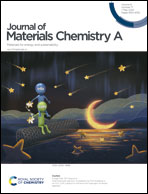An environmentally adaptive quasi-solid-state zinc-ion battery based on magnesium vanadate hydrate with commercial-level mass loading and anti-freezing gel electrolyte†
Abstract
Aqueous zinc-ion batteries (AZIBs) are promising due to their intrinsic safety and low cost. However, the unsatisfactory cathode materials with low mass loading (<3 mg cm−2) and high freezing point of aqueous electrolytes severely limit the application prospects of AZIBs. Herein, Mg0.19V2O5·0.99H2O (δ-MgVO) with a large interlayer spacing of 13.4 Å is synthesized through a facile pre-intercalation strategy, and is used to construct a cathode with a commercial-level mass loading of 10 mg cm−2. At such a high mass loading, the δ-MgVO shows reversible charge storage behavior, high Zn2+ ion diffusion coefficients, and fast electrochemical kinetics. Moreover, a quasi-solid-state battery is assembled by combining the δ-MgVO cathode with polyvinyl alcohol/glycerol gel electrolyte, which shows high ionic conductivity in a wide temperature range (e.g., 10.7 mS cm−1 at −30 °C) and excellent compatibility with a Zn foil anode. Thanks to that, the quasi-solid-state battery exhibits great performances from −30 to 60 °C. Remarkably, at a rather low temperature of −30 °C, an admirable energy density of 48.14 mW h cm−3 (1940 μW h cm−2) can be achieved at 17.83 mW cm−3 (0.72 mW cm−2). Overall, this work opens new opportunities for developing environmentally adaptive aqueous energy storage devices towards practical applications.



 Please wait while we load your content...
Please wait while we load your content...